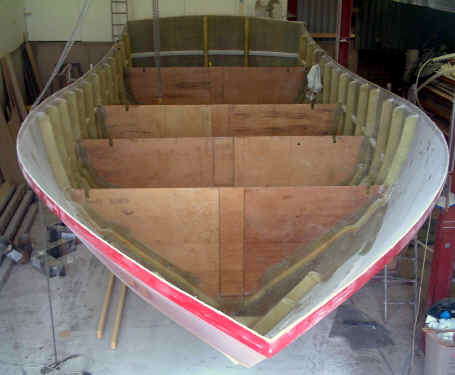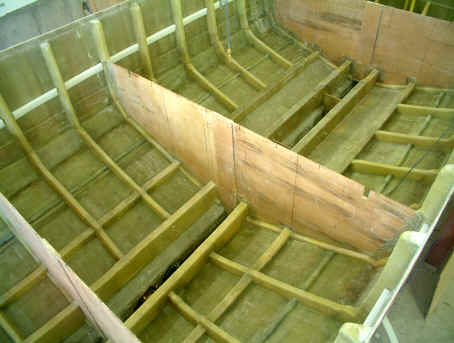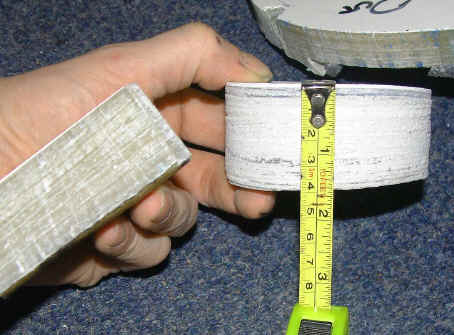

HOME MODEL RANGE CONTACT US GALLERY VIDEO DOWNLOAD PRICE LIST
SAFEHAVEN MARINE. Builders of the Interceptor & Wildcat range of offshore craft
CONSTRUCTION
STRENGTH YOU CAN DEPEND ON!
All Interceptors and Wildcats are of GRP construction. Built in accordance with Lloyds Special Service craft rules to determine panel thickness and scantling spacing for craft operating in up to and including force 8 sea area G3. Built in the traditional transverse framing manor providing a massively strong structure. Our craft have been chosen by pilotage authorities where the maximum hull strength is a top requirement.
Below is a
sample construction schedule of a standard Interceptor 42. With a single engine
she has a 8,500kg (lightship, no fuel) displacement. It is important when
comparing the Interceptor 42 to other 40ft craft, to look at their comparable
displacement, some can be up to 50% lighter. Our Interceptors are very heavily
built, the hull scantlings (frame sizes) and the thickness of the hull results
in a heavier, much stronger boat, built to Lloyds Special Service Craft rules
and regulations, the highest standard in the industry. Obviously a hull with
small two inch frames every four feet apart is not going to be as strong as a
hull which has big four inch frames every eighteen inches apart. At sea this
gives a very solid feel in rough weather, the hull just takes the punishment
without complaint or stress, at sea there is no substitute for size or
displacement, the bigger and heavier the boat the better she is able to
withstand the forces and impacts from waves, whereas a lighter, smaller boat
will bounce around in a lively manor, the heavier boat will just plow through it
all regardless. Its one place where size really does matter! We could of course
build the hull lighter and cheaper, but then the boat would not have the highly
regarded sea keeping and strength of an Interceptor.
Hull laminate schedule / lay up wts -
300gm2 using isophthalic resin. Composite as follows-
900gm2 CSM. isophthalic resin
900gm2 CSM. isophthalic resin
300gm2 CSM stitched in combination too
600gm2 Woven Roving
900gm2 CSM
300gm2 CSM stitched in combination too
600gm2 Woven Roving
900gm2 CSM
300gm2 CSM stitched in combination too
600gm2 Woven Roving
Total shell laminate Bottom - 6600gm2
300gm2 using isophthalic resin. Composite as follows-
900gm2 CSM. isophthalic resin
900gm2 CSM. isophthalic resin
300gm2 CSM stitched in combination too
600gm2 Woven Roving
900gm2 CSM
Sides - 3900gm2
Reinforcement - Keel. Additional 2 x 900gm2 CSM layers extending min 300mm from keel across bottom. Each layer stepped back 25mm. Keel - 8400gm2
Reinforcement - Chines. Additional 2 x 900gm2 CSM layers extending min 10” up sides & across bottom. Each layer staggered min 25mm Chines - 8400gm2
No coloring agent used in lay up.
No longer than 24 hrs between layers to ensure chemical bond.
Immediately after cure of main laminate & whilst still in mould the following stiffening is bonded –
SCANTLINGS.
The vessel is TRANSVERSLY FRAMED at 600mm centres giving approx 400mm panel widths.
Transverse frames- 100mm x100mm @ 600mm centers. Max unsupported panel width, bottom – 450mm . side – 450mm. (measured between stiffeners)
Max span, bottom - 0.90m - 1.5m. side – 1.2m.
Lay up over frames
900gm2 CSM
900gm2 CSM
Min overlap100-125mm
Longditudal Panel breakers- Foam cored 50mm deep x 100mm wide in section, lay up-
900gm2 CSM
900gm2 CSM
1800gm2 total laminate, staggered, min overlap 150mm. Max span .45m
Main Longditudals- Foam cored 200mm deep x 100mm wide in section, lay up-
900gm2 CSM
900gm2 CSM
1800gm2 total laminate, staggered, min overlap 150mm. Max span 2.5m
Engine girders - Wood cored (multiple layers plywood laminated together) 4” wide x 5-12” high.
lay up-
900gm2 CSM
900gm2 CSM
900gm2 CSM
2700gm2 total laminate, staggered, min overlap 150mm. Max span 2.5m
1.6 DECK STRUCTURE
½“
plywood, gell coated bottom, encapsulated 900gm2 top. Supported on
4”x2” longditudal deck beams @ 16”/400mm centres. Bulkheads notched to
receive and bonded. Multiple vertical support beams & webs as per drawing.
Deck shelf foam cored as per drawing and bonded to hull 1800 gm2.
1.7 SUPERSTRUCTURE / WHEELHOUSE CONSTRUCTION
The superstructure consists of a GRP moulding, attached to the deck stainless bolts @ 8” centres and GRP internal angles (1800gm2 min 150mm overlap)
Laminate weights on superstructure are 2100gm2 - 3600gm2 laminate. Additional wood cored stiffening overlaid 1800gm2.
Main roof scantlings are provided by 30 x 75mm transverse frames @ 600mm centres across roof structure. All glassed into superstructure using 1800gm2 laminate with min 50-75mm angles.
Internal partition bulkheads & wood work (seating, lockers etc ) forming additional stiffening to structure which is al glassed into the side laminate.
Engine vents are inboard along the inside of the gunwale.
Non slip deck coating applied to top side walkway.
The aft cockpit gunwale is a GRP Moulding of 2100gm2 through bolted to the hull sides @ 150mm centres with GRP stiffening plates additionally glassed in approx 1,2m spacings.
1.8 BULKHEADS
Three Transverse bulkheads as per drawings constructed from ½ ”/ 12mm plywood overlaid 600gm2 per side with 50 x 50mm vertical webs to provide extra stiffening. The b/heads are set on to the hull by being positioned on top of 50 x 50mm foam cored framing as per drawing to prevent formation of hard spots. And are laminated to the hull using 1800gm2 laminate with a min 6” overlap.
Additional collision b/head is fitted in the bow.
Materials -
All Lloyds approved GRP materials (resin & glass) used in the construction of hull. Details provided.
Below, an Interceptor 42 is lifted from the mould.
Shown below is a standard completed hull with all scantlings & b/heads prior to fitting out.



As you can see from the above photo our hulls are very heavily constructed to survive the pressure and impact loadings encountered when operating in rough offshore conditions.

ENGINERING / ENGINE CHOICE
Below -Single CAT 420-HP Diesel engine installation, also showing deck beams etc.
Twin 300hp engine installation.
Twin VOLVO installation
Big Scania installation in a 38
VOLVO D12 @ 650hp
Caterpillar C12 700hp
We offer a choice of Diesel engines including -
Caterpillars 3056, 3126, 3196 and new C9 range of diesel engines rated at 300 to 670 hp Our standard fitment in the 38 is the 3126 rated at 350hp or the very heavy duty C12 12 litre at 700hp+
Yanmar's range of compact, light 4 & 6 cyl engines most suitable for pleasure / light commercial versions offering excellent power to weight ratios.
Perkins Sabre 212 - 300hp M300TI & M212TC. Most leading makes of engine including Iveco, Cummins & John Derre can be fitted.
Scania's DI9 at 400- 500hp and DI12 to 660hp in very heavy duty instalations.
Volvos D9 & D12 up to 800hp
Daewo's big heavy duty 14 Litre V8 up to 600hp